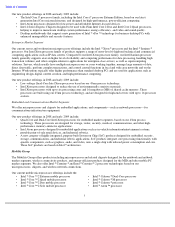Intel 2008 Annual Report Download - page 18
Download and view the complete annual report
Please find page 18 of the 2008 Intel annual report below. You can navigate through the pages in the report by either clicking on the pages listed below, or by using the keyword search tool below to find specific information within the annual report.
Table of Contents
Intellectual Property and Licensing
Intellectual property rights that apply to our various products and services include patents, copyrights, trade secrets,
trademarks, and maskwork rights. We maintain a program to protect our investment in technology by attempting to ensure
respect for our intellectual property rights. The extent of the legal protection given to different types of intellectual property
rights varies under different countries’ legal systems. We intend to license our intellectual property rights where we can obtain
adequate consideration. See “Competition” in Part I, Item 1, “Risk Factors” in Part I, Item 1A, and “Note 24: Contingencies”
in Part II, Item 8 of this Form 10-K.
We have filed and obtained a number of patents in the U.S. and other countries. While our patents are an important element of
our success, our business as a whole is not significantly dependent on any one patent. We and other companies in the
computing, telecommunications, and related high-technology fields typically apply for and receive, in the aggregate, tens of
thousands of overlapping patents annually in the U.S. and other countries. We believe that the duration of the applicable
patents that we are granted is adequate relative to the expected lives of our products. Because of the fast pace of innovation
and product development, our products are often obsolete before the patents related to them expire, and sometimes are
obsolete before the patents related to them are even granted. As we expand our product offerings into new industries, we also
seek to extend our patent development efforts to patent such product offerings. Established competitors in existing and new
industries, as well as companies that purchase and enforce patents and other intellectual property, may already have patents
covering similar products. There is no assurance that we will be able to obtain patents covering our own products, or that we
will be able to obtain licenses from such companies on favorable terms or at all.
The majority of the software that we distribute, including software embedded in our component- and system-level products, is
entitled to copyright protection. To distinguish Intel products from our competitors’ products, we have obtained certain
trademarks and trade names for our products, and we maintain cooperative advertising programs with certain customers to
promote our brands and to identify products containing genuine Intel components. We also protect certain details about our
processes, products, and strategies as trade secrets, keeping confidential the information that we believe provides us with a
competitive advantage. We have ongoing programs designed to maintain the confidentiality of such information.
Compliance with Environmental, Health, and Safety Regulations
Our compliance efforts focus on monitoring regulatory and resource trends and setting company-wide performance targets for
key resources and emissions. These targets address several parameters, including product design; chemical, energy, and water
use; climate change; waste recycling; and emissions.
Intel focuses on reducing natural resource use, the solid and chemical waste by-products of our manufacturing processes, and
the environmental impact of our products. We currently use a variety of materials in our manufacturing process that have the
potential to adversely impact the environment and are subject to a variety of EHS laws and regulations. For example, lead and
halogenated materials (such as certain flame retardants and plastics) have been used by the electronics industry for decades.
Finding suitable replacements has been a technical challenge for the industry, and we have worked for years with our suppliers
and others in the industry to develop lead-free and halogen-free solutions.
We work with the U.S. Environmental Protection Agency (EPA), non-governmental organizations, OEMs, and retailers to
help manage e-waste (which includes electronic products nearing the end of their useful lives) and promote recycling. The
European Union requires producers of certain electrical and electronic equipment to develop programs that allow consumers to
return products for recycling. Many states in the U.S. have similar e-waste take-back laws. The inconsistency of many
e-waste take-back laws and the lack of local e-waste management options in many areas pose a challenge for our compliance
efforts. To mitigate these problems, we work with our distributors to provide recycling options for our products.
13
























